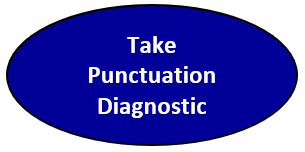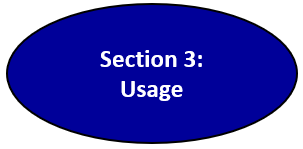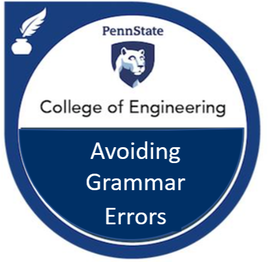Tutorial
Section 2: Punctuation
|
As Theodore Bernstein stated [7], punctuation marks are the traffic signs that help readers navigate sentences. In this analogy, you can think of a period as a stop sign and a comma as a yield sign. In scientific writing, such signs are important. For instance, a mistake in punctuation, such as a missing comma, can force the audience to reread the sentence to gather the intended meaning. Besides periods and commas, another important piece of punctuation is the colon, which can introduce a complex list or an equation. Of lesser importance are the em-dash and semicolon. Still, these two pieces of punctuation occur often enough in scientific writing that they warrant attention.
|
|
If you selected all of the correct answers on the Kahoot, you can move to the next section: Usage. However, if you missed questions, you should work through the films and quizzes (below) that correspond to those missed questions.
|
|
If you struggled with commas, view Films 5-6 and take the review quiz on commas.
|
Film 5: Two Important Rules for Commas in Scientific Writing. Film 6: Third Important Rule for Commas in Scientific Writing. |
|
If you struggled with colons, em-dashes, or semicolons, view Films 7-9 and take the review quiz on colons, dashes, and semicolons.
|
Film 7: Colons in Scientific Writing. Film 8: Em-Dashes in Scientific Writing. Film 9: Semicolons in Scientific Writing. |
Congratulations on finishing the punctuation section.
Acknowledgments
This self-study guide was made possible by funds provided by the Leonhard Center for the Enhancement of Engineering Education in the College of Engineering at Pennsylvania State University. Providing technical assistance on the films is the Office of Digital Learning, which is also in the College of Engineering at Penn State.
This self-study guide was made possible by funds provided by the Leonhard Center for the Enhancement of Engineering Education in the College of Engineering at Pennsylvania State University. Providing technical assistance on the films is the Office of Digital Learning, which is also in the College of Engineering at Penn State.
Role |
Name |
Department |
Institution |
Faculty Editor |
Professor Michael Alley |
College of Engineering |
Penn State |
Film Editor |
Casey Fenton |
Office of Digital Learning |
Penn State |
Film Editor |
Elaine Whitmer |
Office of Digital Learning |
Penn State |
Student Editor, 2022 |
Olivia Brencovich |
Mechanical Engineering |
Penn State |
Website Editor, 2022 |
Marissa Beighley |
Computer Science |
Penn State |
References
- Peg Tyre, "The Writing Revolution," The Atlantic Monthly (October 2012), pp. 99-100.
- Catherine Walker, "Time to Stop Avoiding Grammar Rules," The Guardian (September 2012).
- Tessa Schlesinger, "Why Grammar Matters," Owlcation (7 September 2017).
- Michael Alley, The Craft of Scientific Writing, 4th ed. (New York: Springer, 2018), Appendices A, B, and C.
- Cheryl Glenn and Loretta Gray, The Writer's Harbrace Handbook, 5th ed. (Boston: Cengage Learning, 2012).
- William A. Sabin, The Gregg Reference Manual: A Manual of Style, Grammar, Usage, and Formatting, 11th ed. (New York: McGraw-Hill, 2010).
- Theodore Bernstein, The Careful Writer, 2nd ed. (New York: Free Press, 1995).
Please feel free to provide comments, questions, and suggestions for the films, text, and quizzes of this website. To help us understand your feedback, please let us know whether you are a student or faculty member (or other professional).





